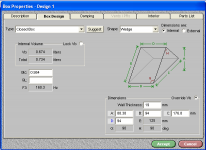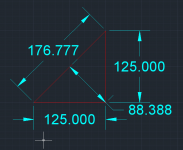Dirac will have built in limits as to how much it can cut and boost. Remember it is room correction software and you are trying to get it to do speaker correction and room correction at the same time. The closer you get the speaker to be flat before the better. If you try and do it all with dirac in one go I think you might be disappointed but hey I have never tried it.
The more processing that Dirac has to do makes it more likely that it will only be correct for one point where you measured. To get a better off axis spread you want to limit the amount of room correction.
Wesayso's use of room correction software is a really good way of using a fine grain FIR filter to adjust frequency and phase response of the speaker in the mid to higher frequencies and progressively more room as the frequency goes down. You cannot get the same result with an automated system yet.
Frequency response issues in the modal region respond well to EQ, acoustic issues or non minimum phase problems do not. Room correction will try to fix both because it is a machine trying to fit a response to a curve. It doesn't know that by doing that it will sound wrong.
The overriding thing I have taken from wesayso's journey is that to get the best result you need to go the extra mile as far as you can. Every time you compromise for the sake of making it easier to build or easier to eq the result gets worse. How much worse is hard to say but try and do as much as are willing to as it will pay you back.
I see what you're saying. Will be interesting to see what I can get out of the Dirac vs. PEQ vs. JRiver. I anticipate the journey will be a long and winding one! I also have a miniDSP that could enter the mix at some point!
i will wait for your result
looks like your hard work will be paying with great sound
just my advice for you
using 2 different sub at front and rear
at front using more than 2 subwoofer 15 inch
at rear using under 2 subwoofer 15 inch
it will completing bass response
but those subwoofers boxes outside wall but highly pressed with no gaps in the wall
and they are non-sealed box
i have tried it for one of my customer 7 months ago
great result, he and his family loving it
unfortunately, i can't take picture cause my customer will not give permission again
he will give permission for me if he got trouble for his electricity and all of his electronic devices
looks like your hard work will be paying with great sound
just my advice for you
using 2 different sub at front and rear
at front using more than 2 subwoofer 15 inch
at rear using under 2 subwoofer 15 inch
it will completing bass response
but those subwoofers boxes outside wall but highly pressed with no gaps in the wall
and they are non-sealed box
i have tried it for one of my customer 7 months ago
great result, he and his family loving it
unfortunately, i can't take picture cause my customer will not give permission again
he will give permission for me if he got trouble for his electricity and all of his electronic devices
Last edited:
i will wait for your result
looks like your hard work will be paying with great sound
just my advice for you
using 2 different sub at front and rear
at front using more than 2 subwoofer 15 inch
at rear using under 2 subwoofer 15 inch
it will completing bass response
but those subwoofers boxes outside wall but highly pressed with no gaps in the wall
and they are non-sealed box
i have tried it for one of my customer 7 months ago
great result, he and his family loving it
unfortunately, i can't take picture cause my customer will not give permission again
he will give permission for me if he got trouble for his electricity and all of his electronic devices
I'm planning on getting the line arrays situated first. And I have an infinite baffle subwoofer waiting in the wings as well. Two Stereo Integrity 18" drivers positioned at the front. TBD as to whether I'll do .2 or .1. Leaning toward .1 to minimize the complexity and visual footprint so my wife doesn't kill me. I may start another thread for that once the time comes.
I want my cake and eat it too! Perhaps I'm putting too much value in the concept of having the drivers as close to the wall as possible
I actually think that this is a negative point of these types of triangular enclosures in that there is very little distance to the back wall of the cabinet. That means that it is more likely that you will get interference from the back wave not being fully absorbed inside the cabinet and being retransmitted back through the cone later in time. The wave has to go through the stuffing twice to get out but if the distance is short enough it will.
I'd like each driver to have 2.0L of space. The resulting dimensions if I did my math correctly was a right isoceles triangle with interior dimensions of about 125mmx125mm. This was not accounting for braces and driver volume but did include extra space because the vertical length was able to accommodate 28 drivers vs the 25 I planned on (93" floor to ceiling). I would also assume mounting the drivers on a 3/4" baffle from the outside.
Understood. Perhaps 1/2" solid bracing for every five drivers and then cut out braces everywhere else.
Thanks for checking my math with Bassbox!
I think your maths is wrong or your remembering the dimensions.
I have put this into Bassboxx Pro for you and also drawn it out in CAD to confirm the dimensions.
125mm sides leads to a 176mm baffle but only 88mm from the baffle to the point of the triangle which I think is very close.
It also leads to a much smaller volume, actual volume of 0.674L effective volume of 0.734 L when damping is taken into consideration. Q of 0.954 is a bit high. It is still doable with correction but not ideal. Also not bracing or structure in there so the end result will be worse.
I have used 94mm as the height of the enclosure as this is the height of your 93" divided by 25. Also remember that if you are going to separate the enclosures you want them to be the same volume and you can't do that if you have a bit more in the top and bottom sections.
Check my working but I think this is correct as CAD and Bassbox Pro agree, so does Pythagoras.
If you want to change any of the dimensions let me know as the programs will sit open for a while.
See this is how I keep getting distracted
Attachments
Well, this is embarrassing. I looked back at my hand sketch and realized that I scaled everything 1:2. I would have eventually modeled it upon finalizing the concepts but good to catch it now! Thanks for modeling. I was wondering why RA7s baffle looked so wide!
Anyhow, maybe we should work this backwards. What dimension does bass box say for a 2.0L per driver volume? Let's consider no extra space top and bottom. But 1/2" dividers between each driver to be conservative.
Thx for being distracted!
Anyhow, maybe we should work this backwards. What dimension does bass box say for a 2.0L per driver volume? Let's consider no extra space top and bottom. But 1/2" dividers between each driver to be conservative.
Thx for being distracted!
Well, this is embarrassing. I looked back at my hand sketch and realized that I scaled everything 1:2. I would have eventually modeled it upon finalizing the concepts but good to catch it now! Thanks for modeling. I was wondering why RA7s baffle looked so wide!
Anyhow, maybe we should work this backwards. What dimension does bass box say for a 2.0L per driver volume? Let's consider no extra space top and bottom. But 1/2" dividers between each driver to be conservative.
Thx for being distracted!
It is harder to work to an exact volume as I have to add the dimensions in by hand to make it work.
Here are a few options.
175mm sides 247mm baffle, 1.286L Q 0.85
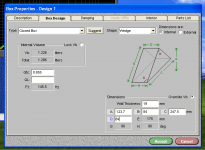
212mm sides 300mm baffle 1.89L Q 0.806
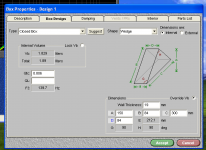
if you remove the volume for a 1/2"solid brace for each driver on a 300mm baffle you go back to 1.6L per driver.
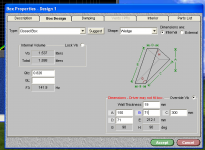
To get to 2L with 1/2" dividers the baffle is 340mm wide wide 240mm sides. Pretty wide.
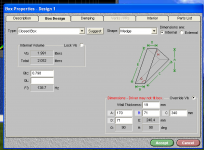
Here is an overlay of my cabinet dimensions with the 125mm red lines as before. the blue circle is an indication of where you could good wrap the fabric around, make it the same colour as your walls and it would pretty much disappear.
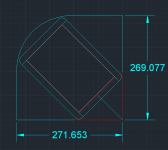
Where is your build thread!? Would love to see your progress.
Here it is, a fair reflection of current progress.
http://www.diyaudio.com/forums/full-range/303417-full-range-tc9-line-array-cnc-cabinet.html#post4979544
Thanks for running the scenarios fluid! I wonder if I should further consider actually using the volume inside the walls to get the baffle narrower. Or just give up on the concept entirely and go down a path more similar to yours/wesayso's or where I started with the murphy design. Or just living with the compromise of smaller enclosure and higher Q. I do plan on having infinite baffle subs so they don't need to go that low. And I will have plenty of power to EQ the low end up quite a bit. But it would be nice to optimize the towers independent of those levers.
I'm pretty sure I know what the peanut gallery would do. Maybe RA7 will have an interesting perspective now that he's reappeared!
Maybe RA7 will have an interesting perspective now that he's reappeared!
I'm pretty sure I know what the peanut gallery would do.
....to minimize the complexity and visual footprint so my wife doesn't kill me....
well...
wish your wife really really really don't kill you...
so your planning is for great design great result but "hiding" inside wall so everyone will feel that room so wide not fully with huge size loudspeakers and huge group speakers
am i right???
you will need great deals and great power bro
wish you have more patience cause patience always bring great result
If you have subs, don't worry too much about the cabinet size. If you want the benefits of the corner, the goal should be to push them as far back into the corner as possible.
A single TC9 has no business reproducing anything below 80 Hz, at least in my mind. You don't want to push the driver below it's resonant frequency because excursion is not well controlled. Even though you have 25 of them per side and there is little excursion per driver, I just don't think it's a good idea to push drivers outside their intended range, especially in the bass where distortion can sky rocket.
Wesayso has shown that it can be done, but I'm sure he'll agree that he'd like to have a couple of subs for the bottom end.
A single TC9 has no business reproducing anything below 80 Hz, at least in my mind. You don't want to push the driver below it's resonant frequency because excursion is not well controlled. Even though you have 25 of them per side and there is little excursion per driver, I just don't think it's a good idea to push drivers outside their intended range, especially in the bass where distortion can sky rocket.
Wesayso has shown that it can be done, but I'm sure he'll agree that he'd like to have a couple of subs for the bottom end.
What volume per driver did you end up with in yours and would you recommend anything different? Also, did you have any problems with your cabinets touching the walls? Or more directly, any concerns about my idea of using the walls themselves as the rear side of the cabinet (they are 5/8" plywood under 5/8" drywall).
Wesayso has shown that it can be done, but I'm sure he'll agree that he'd like to have a couple of subs for the bottom end.
I can't deny it has been on my mind. Most people that have heard the arrays do feel I am crazy for considering to add any subs. For music I don't really need it. You've got to hear it to truelly believe what these arrays can do. As these are going to double for HT adding subs make sense. How to do it would depend on personal goals.
The beauty of EQ/FIR is that I can have different settings for different situations. I suppose I could sacrifice cabinet size knowing that I can EQ up some bass for music without losing much (if anything) and then either simply integrate the subs for lower frequencies or even have a separate profile for HT entirely.
The question is where to draw the line to determine the interior volume? I need an optimization program to balance all the variables!
The question is where to draw the line to determine the interior volume? I need an optimization program to balance all the variables!
Last edited:
Yes, trying to formulate those goals now. I think they will center around the sound "quality", aesthetics (WAF), the balance between 2-channel and HT.
Might need some help with how to translate those goals into hard design decisions so thanks in advance to everyone for the education and guidance there! It really is amazing how much knowledge is in this community and how willing people are to share and help. Hopefully, over time, I will be able to contribute back a fraction of as much as I have benefited.
Might need some help with how to translate those goals into hard design decisions so thanks in advance to everyone for the education and guidance there! It really is amazing how much knowledge is in this community and how willing people are to share and help. Hopefully, over time, I will be able to contribute back a fraction of as much as I have benefited.
Ok, here goes... this is a bit of a summary of what's been discussed but I tried to weigh the pros and cons and then make decisions based on the goals/priorities.
1. Minimum footprint/aesthetic impact: Try to make these visually disappear into the room as much as possible. Translation - what's a reasonable minimum volume per driver for the FR to go low enough to cross over to the subs while considering reasonable boost due to both corner loading as well as EQ. Although a QTc of .707 seems to be a common target, my thought is that I can probably get away with something closer to 1.0 with the aforementioned boosts and still have a reasonable rolloff to the subwoofers. Does that seem reasonable? I know that a larger volume has benefits, but given the goal here, it seems this is a workable compromise. (I realize I haven't talked about the subwoofers themselves, but for context, they are 2 18" stereo integrity units that will be driven by an iNuke 3000.)
2. Sound cabinet design: Independent of the volume that gets me to a QTc around 1.0, there are considerations to make sure that the cabinet design supports a high quality result.
Issue 1: The enclosure should be able to deal with potential back wave issues per fluid's comment in post 164. That may mean a larger enclosure or some other way of deflecting the back wave. I'm not sure if the triangular shape helps or hurts this. On one hand, the rear is closer to the driver than with a traditional design. On the other hand, the rear is angled so the wave would be reflected back at an angle although I suppose they would sum on the way back anyway? Another thought is to use a 1" diameter cylindrical dowel between braces at the rear (near the 90 degree vertex) so that could further scatter the back wave? I'm unclear as to how to predict this other than building a test enclosure. So I may do that once the general design parameters are decided upon. But I would lean towards being aggressive on this given the distribution of energy across so many drivers means each driver won't need to work that hard and so the back wave strength won't be terribly high either. I will stuff with fiberglass as wesayso has described to help mitigate this as well. If there are still issues, I could add wool as he did as well.
Issue 2: The fact that the cabinet will be built onto an existing wall that is framed by 2x4s anchored to a massive concrete foundation below and laminated 2x12 joists above, has a 4x4 post at the corner, and will have the two rear faces made up of both 5/8" drywall and 5/8" plywood actually makes me feel pretty good about the enclosure generally speaking. The weakness will be in the front baffle which brings me to the bracing. Given bracing takes up internal volume, I am likely to simply put one window brace every five drivers. I understand some like to seal these up the five drivers wired in series at a time but I want to take advantage of the additional vertical space at the top and bottom and I can't create five equal volumes if I use solid braces. Also, using window braces lets the drivers breathe a little better. One nuance here is that I could offset the "window" in the braces and alternate them in order to further break up any standing waves that might form along the length of the enclosure.
Issue 3: In previous posts, we had discussed using wool felt... no change to that plan I don't think. The one design decision here was to mount the drivers from the outside and using the felt to create a smooth transition to the baffle and then doubling up the felt closer to the wall junction for further absorption. Mounting to the outside also minimizes interior volume taken up by the drivers themselves. This is not insignificant when there are 25 drivers, the baffle is 3/4" thick and the interior volume is as small as it is.
I think that's it. What it boils down to is minimizing the size of the array to where it can still integrate with the subwoofer. The smaller size actually helps in some regards as the resonance frequency of the cabinet will increase higher with smaller dimensions.
In any case, let me know if my logic is flawed somewhere. I know my priorities may not align with everyone so thanks in advance for keeping those in mind in your feedback.
1. Minimum footprint/aesthetic impact: Try to make these visually disappear into the room as much as possible. Translation - what's a reasonable minimum volume per driver for the FR to go low enough to cross over to the subs while considering reasonable boost due to both corner loading as well as EQ. Although a QTc of .707 seems to be a common target, my thought is that I can probably get away with something closer to 1.0 with the aforementioned boosts and still have a reasonable rolloff to the subwoofers. Does that seem reasonable? I know that a larger volume has benefits, but given the goal here, it seems this is a workable compromise. (I realize I haven't talked about the subwoofers themselves, but for context, they are 2 18" stereo integrity units that will be driven by an iNuke 3000.)
2. Sound cabinet design: Independent of the volume that gets me to a QTc around 1.0, there are considerations to make sure that the cabinet design supports a high quality result.
Issue 1: The enclosure should be able to deal with potential back wave issues per fluid's comment in post 164. That may mean a larger enclosure or some other way of deflecting the back wave. I'm not sure if the triangular shape helps or hurts this. On one hand, the rear is closer to the driver than with a traditional design. On the other hand, the rear is angled so the wave would be reflected back at an angle although I suppose they would sum on the way back anyway? Another thought is to use a 1" diameter cylindrical dowel between braces at the rear (near the 90 degree vertex) so that could further scatter the back wave? I'm unclear as to how to predict this other than building a test enclosure. So I may do that once the general design parameters are decided upon. But I would lean towards being aggressive on this given the distribution of energy across so many drivers means each driver won't need to work that hard and so the back wave strength won't be terribly high either. I will stuff with fiberglass as wesayso has described to help mitigate this as well. If there are still issues, I could add wool as he did as well.
Issue 2: The fact that the cabinet will be built onto an existing wall that is framed by 2x4s anchored to a massive concrete foundation below and laminated 2x12 joists above, has a 4x4 post at the corner, and will have the two rear faces made up of both 5/8" drywall and 5/8" plywood actually makes me feel pretty good about the enclosure generally speaking. The weakness will be in the front baffle which brings me to the bracing. Given bracing takes up internal volume, I am likely to simply put one window brace every five drivers. I understand some like to seal these up the five drivers wired in series at a time but I want to take advantage of the additional vertical space at the top and bottom and I can't create five equal volumes if I use solid braces. Also, using window braces lets the drivers breathe a little better. One nuance here is that I could offset the "window" in the braces and alternate them in order to further break up any standing waves that might form along the length of the enclosure.
Issue 3: In previous posts, we had discussed using wool felt... no change to that plan I don't think. The one design decision here was to mount the drivers from the outside and using the felt to create a smooth transition to the baffle and then doubling up the felt closer to the wall junction for further absorption. Mounting to the outside also minimizes interior volume taken up by the drivers themselves. This is not insignificant when there are 25 drivers, the baffle is 3/4" thick and the interior volume is as small as it is.
I think that's it. What it boils down to is minimizing the size of the array to where it can still integrate with the subwoofer. The smaller size actually helps in some regards as the resonance frequency of the cabinet will increase higher with smaller dimensions.
In any case, let me know if my logic is flawed somewhere. I know my priorities may not align with everyone so thanks in advance for keeping those in mind in your feedback.
Well all of my rationale has been typed down in my thread, so I won't repeat it here  .
.
In short: I consider every part important that makes a measurement deviate from what it should be. I wanted to maximise the ideal, but do it in a living room. Not easy and it took me long enough. I'd say I've come very close to that goal, by sticking to the measured results. I don't assume, I measure to know. Yes, I still use my ears .
.
I won't expect anyone to have the same goals as me, I just shared them to make others think about it, discus and get new ideas. I don't regret a minute I spend. My results blew me away. They still do, this wasn't a passing fancy. I treated it as an engineering problem.
I should add: I'm not done yet! I will continue to make minute changes (or larger ones) to get even better measurements. It's just too much fun!
I would advise you to make test enclosures with a single driver and measure to learn the consequences of the compromise you end up with. At least, that's what I would do. (don't assume, measure )
)
In short: I consider every part important that makes a measurement deviate from what it should be. I wanted to maximise the ideal, but do it in a living room. Not easy and it took me long enough. I'd say I've come very close to that goal, by sticking to the measured results. I don't assume, I measure to know. Yes, I still use my ears
I won't expect anyone to have the same goals as me, I just shared them to make others think about it, discus and get new ideas. I don't regret a minute I spend. My results blew me away. They still do, this wasn't a passing fancy. I treated it as an engineering problem.
I should add: I'm not done yet! I will continue to make minute changes (or larger ones) to get even better measurements. It's just too much fun!
I would advise you to make test enclosures with a single driver and measure to learn the consequences of the compromise you end up with. At least, that's what I would do. (don't assume, measure
Last edited:
The beauty of EQ/FIR is that I can have different settings for different situations. I suppose I could sacrifice cabinet size knowing that I can EQ up some bass for music without losing much (if anything) and then either simply integrate the subs for lower frequencies or even have a separate profile for HT entirely.
The question is where to draw the line to determine the interior volume? I need an optimization program to balance all the variables!
You can certainly have different EQ profiles and that is the beauty of electronic correction but do not confuse that with meaning you can have a tiny cabinet and get the same response just by EQ'ing. Hoffman's iron law still applies, small, loud, low, you can only pick two.
What you could do is have full correction to the lowest notes for music playing without subs and sacrifice maximum output.
The other preset could have a higher F3 with less boost and then you can crank the volume.
Here are some comparisons for cabinets at both ends of the volume and Q spectrum being considered.
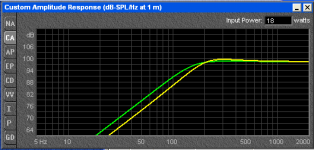
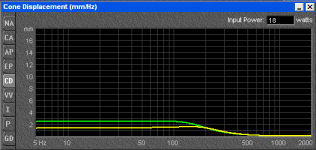
The green has a Q of 0.8 and has a very slight rise to the low end which is hard to see given the scale of the graph. A single driver is pushed to x-max with 18 watts. This is my cabinet modelled.
The yellow is the dimensions you gave to start with of 125mm triangular sides, 176mm baffle. Q of 0.98. You get a slight boost in output from the cabinet from mid frequencies down until you get to 250Hz then it starts to drop. From 100Hz on down you are almost 6dB less in output. The excursion is less so you can put in more power but to get back to the same point you need to put in 72 watts instead of 18 (x2 then x2). Two problems, first you are now way over the thermal limit of the driver and will cook it, this is only one driver so instead of say 250W to drive the 25 you now need over a kilowatt to get back to the same output. Second that is a lot more power and the amp may not perform so well increasing thd but you can't use it anyway because of point one!
This is how easy it is to think you can eq your way out of trouble unless you work out just what other compromises you make to get there.
The Fs of the TC9 is 125Hz sow however you use it you will be using it well below it's free air resonance. Wesayso's distortion seems OK to me. It certainly rises lower down, but most subwoofers are not actually that low in distortion anyway so to better the array by themselves will need a high quality low distortion woofer. For home theatre almost any sub would blow them out of the water as power is king for LFE.
- Status
- This old topic is closed. If you want to reopen this topic, contact a moderator using the "Report Post" button.
- Home
- Loudspeakers
- Full Range
- "Wall-integrated" corner loaded line array with Vifa TC9 drivers
